| CHAPTER IV: BOOK-MAKING AND COLLECTING IN THE RELIGIOUS
HOUSES Old English libraries; the making, collection and use of books during the middle ages | ||
1. § I
Piers Plowman, B. x. 300
BEFORE leaving the subject of monastic libraries, it is desirable to say something about their economy.
They were built up partly by importing books, partly by bequests from wealthy ecclesiastics, but largely—and in some cases wholly—by the labours of scribes. The scene of the scribe's craft was the scriptorium or writing-room, which was usually a screened-off portion of the cloister, or a room beside the church and below the library, as at St. Gall, or a chamber over the chapter-house, as at St. Albans under Abbot Paul, at Cockersand Abbey and Birkenhead Priory. As a rule the monk was not allowed to write outside the scriptorium, although in some houses he could read elsewhere—as at Durham, where a desk to support books was fitted in the window of each dormitory cubicle. But brothers whose work was highly valued were allowed a small writing-room or scriptoriolum. Nicholas, Bernard's secretary, had a room on the right of the cloister with its
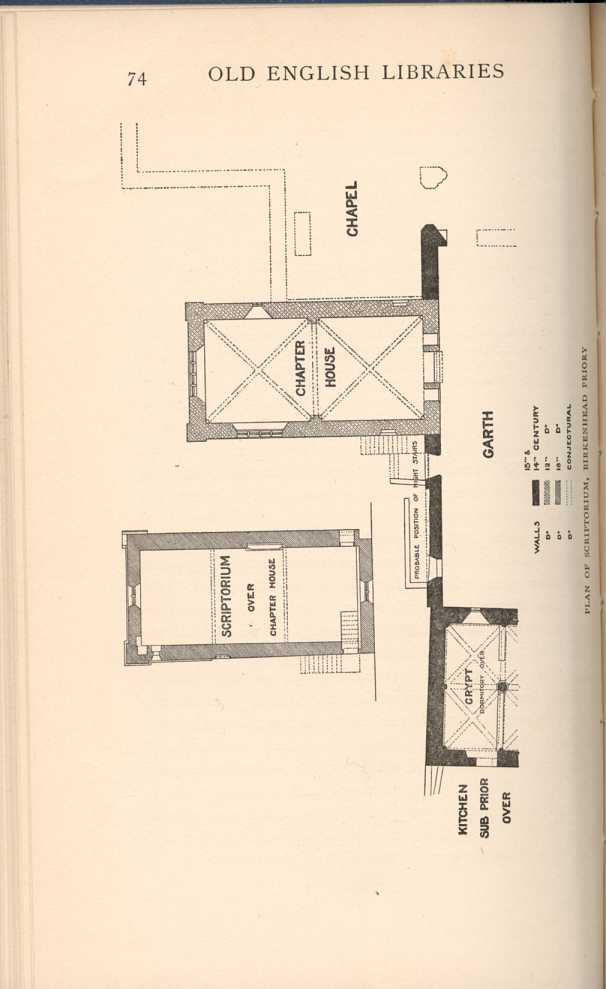 [Description: PLAN OF SCRIPTORIUM, BIRKENHEAD
PRIORY]
[Description: PLAN OF SCRIPTORIUM, BIRKENHEAD
PRIORY]The arrangements in the cloister are carefully described in the Durham Rites. At Durham "in the north syde of the cloister, from the corner over against the church dour to the corner over againste the Dortor dour, was all fynely glased, from the highs to the sole within a litle
The Carthusian Rule records that few monks of the order could not
write.[4.8] But this was by no means
invariably the case. In early monastic times writing was usually the
occupation of the weaker brethren: for example,
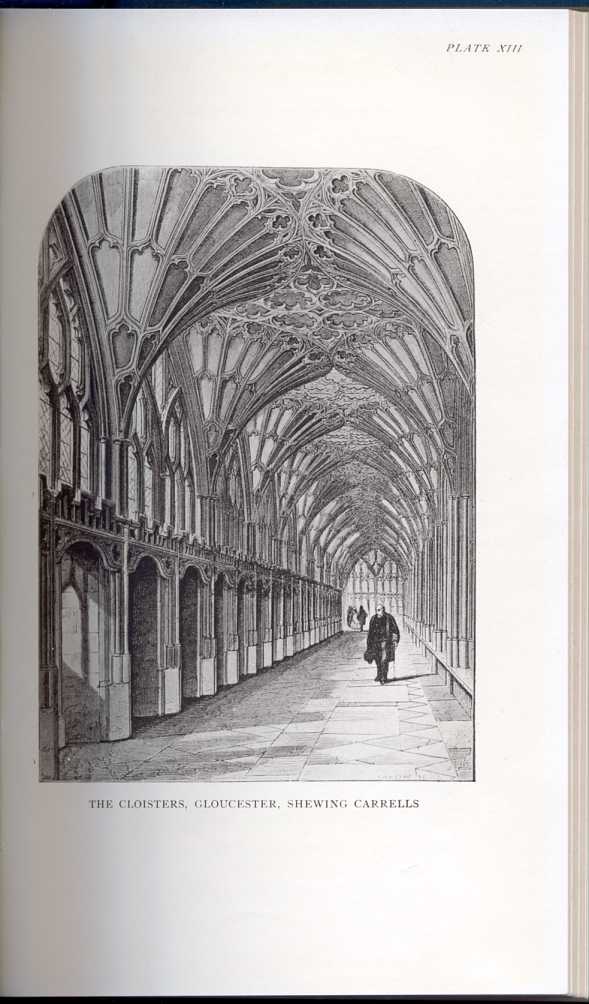 [Description: THE CLOISTERS, GLOUCESTER, SHEWINCG
CARRELLS]
[Description: THE CLOISTERS, GLOUCESTER, SHEWINCG
CARRELLS]
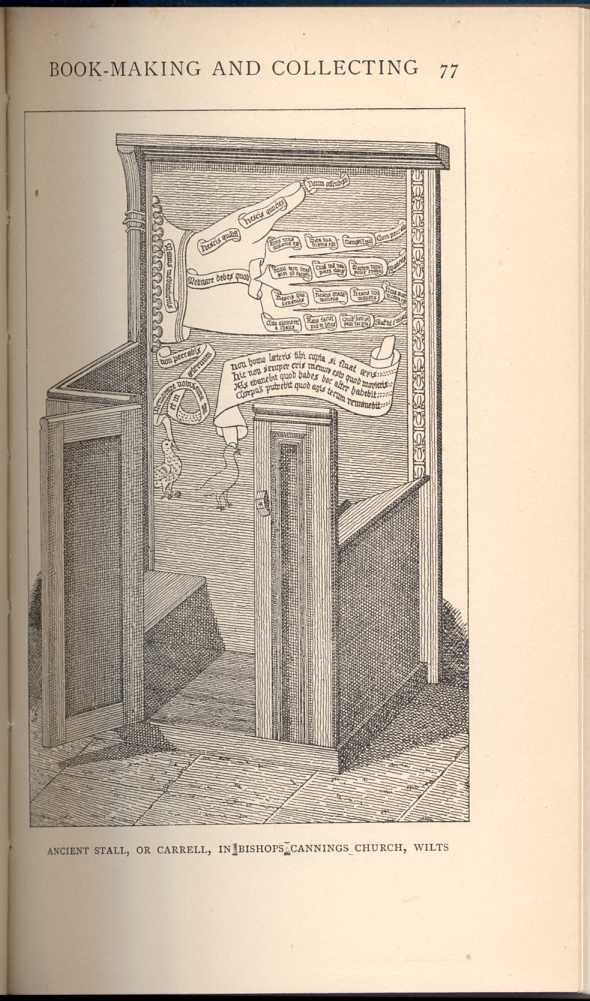 [Description: ANCIENT STALL, OR CARRELL, IN BISHOP
CANNINGS CHURCH, WILTS]
[Description: ANCIENT STALL, OR CARRELL, IN BISHOP
CANNINGS CHURCH, WILTS]When books were not otherwise obtainable, or not obtainable quickly enough, it was the practice to hire scribes from outside the house. Abbot Gerbert, in a letter to the abbot of Tours, mentions that he had been paying scribes in Rome and various parts of Italy, in Belgium, and Germany, to make copies of books for his library "at great expense."[4.11] At Abingdon hired scribes were sometimes employed, and the rule was for the abbot to find the food, and the armarius, or librarian, to pay for the labour. [4.12] This was commonly done when libraries were first formed. When Abbot Paul began to collect a library at St. Albans none of his brethren could write well enough to suit him, and he was obliged to fill his writing-room with hired scribes. He supplied them with daily rations out of the brethren's and cellarer's alms-food; such provision was always handy, and the scribes were not retarded by leaving their work.[4.13] Sometimes scribes were employed merely to save the monks trouble. At Corbie, in the fourteenth century, the religious neglected to work in the writing-room themselves, but allowed benefactors to engage professional scribes in Paris to swell the number of books. The Gilbertine order forbade hired scribes altogether, perhaps wisely.
The scribe's method of work was simple. First he;: took a metal
stylus or a pencil and drew perpendicular lines in the side margins of
his parchment, and horizontal lines at equal distances from top to
bottom of the page. Then the task of copying was straightforward. If
the book was to be embellished he left spaces for the illuminator to
fill in. When the illuminator took the book over, he carefully sketched
in his designs for the capitals and miniatures, and then worked over
them in colour, applying one colour to a number of sketches at a time.
Anybody who is curious as to medieval methods of illuminating should
read a little fifteenth-century treatise which describes "the crafte of
lymnynge of bokys." "Who so kane wyesly considere the nature of his
colours, and kyndely make his commixtions with naturalle proporcions,
and mentalle indagacions connectynge fro dyvers recepcions by resone of
theyre naturys, he schalle make curius colourys." Thereafter follow
recipes to "temper vermelone to wryte therewith"; "to temper asure,
roses, ceruse, rede lede," and other pigments; "to make asure to schyne
 ," "to make letterys of
gold," "blewe lethyre," and "whyte lethyre"; with other curious
information. [4.14]
," "to make letterys of
gold," "blewe lethyre," and "whyte lethyre"; with other curious
information. [4.14]
In monasteries where the rule was strict the scribe wrought at his task for six hours daily.[4.15] All work was done by daylight, artificial light not being allowed. Lewis, a monk of Wessobrunn in Bavaria, in a copy of Jerome's Commentary on Daniel, speaks of writing when he was stiff with cold, and of finishing by the light of night what he could not copy by day. [4.16] Such diligence was not usual.
In summer-time work in the cloister may well have
A scribe could only write what the abbot or preceptor set him. When his portion had been given out he could not change it for another.[4.19] If he were set to copy Virgil or Ovid or some lives of the saints the task would conceivably be pleasant. But such was seldom the scribe's fortune. The continual transcription of Psalters and Missals and other service books must have been infinitely wearisome, at any rate, to the less devout members of the community. In some large and enterprising houses a scribe copied only a fragment of a book. Several brethren worked upon the same book at once, each beginning upon a skin at the point where another scribe was to leave off.[4.20] Or the book to be transcribed was dictated to the scribes, as at Tours under Alcuin. Both methods had the advantage of "publishing" a book quickly, but the work was as
When a manuscript was fully written the scribe wrote his colophon or "explicit," a short form of the phrase "explicitus est fiber." Sometimes the scribe plays upon words, thus: "Explicit iste liber; sit scriptor crimine liber"; or he exultantly praises: "Deo gratias. Ego, in Dei nomine, Warembertus scripsi. "Deo gratias"; or he is modest: "Nomen scriptoris non pono, quia ipsum laudare nolo"; [4.21] or he feels querulous: "Be careful with your fingers; don't put them on my writing. You do not know what it is to write. It is excessive drudgery: it crooks your back, dims your sight, twists your stomach and sides. Pray then, my brother, you who read this book, pray for poor Raoul, God's servant, who has copied it entirely with his own hand in the cloister of St. Aignan." Another inscription, in a manuscript at Worcester Cathedral, suggests that books were not read: why, argues this monk, write them?—nobody is profited; books are for the edification of readers, not of scribes. Note also the following:—
Vinum scriptori debetur de meliori
Hic liber est scriptus qui scripsit sit benedictus. Amen.[4.22]
whyche fallen moste commune and withe þe grace of gode I
will writte þe ij Boke þe whyche ys cleped the Antitodarie
Explicit quod scripcit Thomas Rosse.[4.23]
To a poor Raoul of mechanical ability the rule of silence must
have been very irksome; the student would be grateful for it. Alcuin
forbade gossip to prevent mistakes in copying. Among the Cluniacs the
rule was strictly enforced in the church, refectory, cloister, and
dormitory. A chapter of the Cistercian order (1134) enjoined silence in
all rooms where the brethren were in the habit of writing.
[4.24] The better to maintain silence nobody was
permitted to enter the scriptorium save the abbot, the prior and
sub-prior, and the preceptor. When necessary it was permissible to speak
in a low voice in the ear; But among the Cluniacs whispering was avoided
as far as possible. Watch the monks communicating with the librarian.
One wants a Missal, and he pretends, as the children say, to turn over
leaves, thereby making the general sign for a book; then he makes the
sign of the Cross to indicate that he wants a Missal book. Another wants
the Gospels, and he makes the sign of the Cross on the forehead. This
brother wants a pagan book, and, after making the general sign, he
scratches his ear with his finger as an itching dog would with his feet;
infidel writers were not unfairly compared with such creatures.
[4.25] If such sign-language were really
maintained, it must have been extensively supplemented as the library
grew in size, for although striking the thumb and little
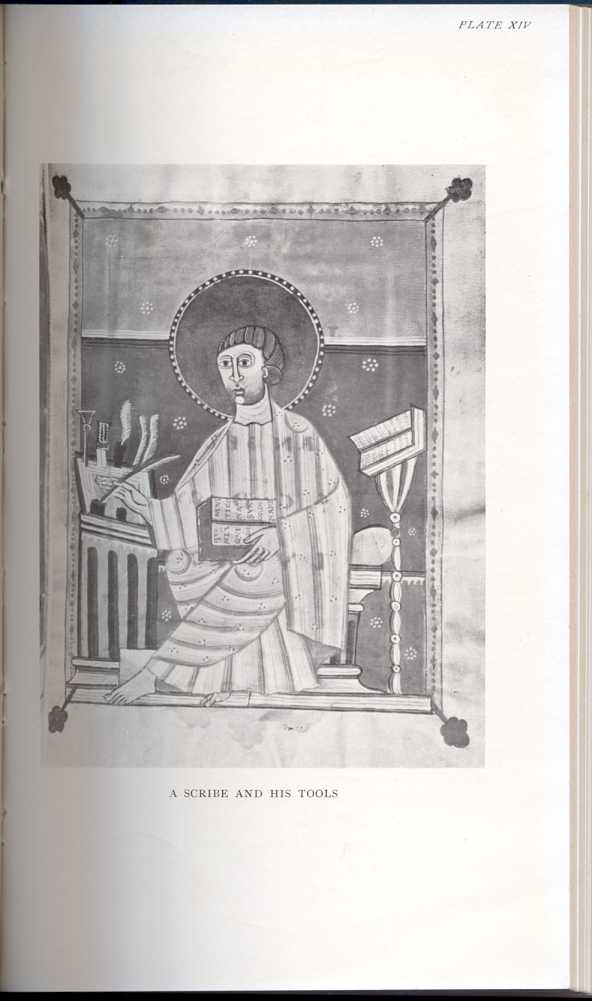 [Description: A SCRIBE AND HIS TOOLS]
[Description: A SCRIBE AND HIS TOOLS]
For notes, exercises, brief letters, bills, first drafts, daily, services of the church, the names of officiating brethren,— for all temporary purposes waxed tablets were used. They were in common use from classic times: some Greek and many Latin tablets are still preserved;[4.27] they were much used in ancient Ireland, as we have seen; and they continued to be of service until the late Middle Ages. Anselm habitually wrote his first drafts upon them. At St. Augustine's Abbey, Canterbury, the monks were supplied with tablets, for a novice's outfit included, after profession, a stylus, tablets, and a knife.[4.28] The writing was scratched on the wax with a stylus, a sharp instrument of bone or metal. The other end of it was usually flattened for pressing out an incorrect letter; among the Romans the term "vetere stylum" became common in the sense of correcting a work.
For all permanent purposes "bōc-fel," or book-skin, was
used; either vellum or "parchëmyn smothe, whyte and scribable."
Vellum and parchment were interchangeable terms in medieval times; but
parchment was commonly used. In early monastic days it was prepared by
the monks themselves, being rubbed smooth with pumice-stone;
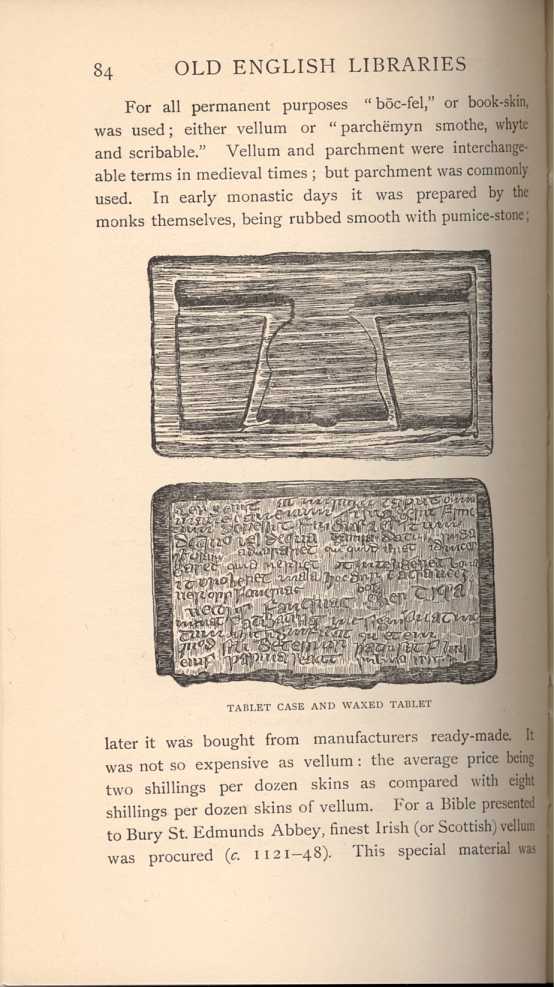 [Description: TABLET CASE AND WAXED
TABLET]
[Description: TABLET CASE AND WAXED
TABLET]
The pens used for writing were either made of reeds (calami) or of quills (pennae). The quill was introduced after the reed, and largely, though not entirely, superseded it. Other implements of the expert scribe were a pencil, compasses, scissors, an awl, a knife for erasures, a ruler, and a weight to keep down the vellum.
Numerous passages might be dug out of old records warning scribes against errors in transcribing. Ælfric, in the preface to his homilies, adjures the copyist, by our Lord Jesus Christ and by His glorious coming, to transcribe correctly. Chaucer, in a well-known verse, expresses his wish that Adam the scrivener shall copy Boëthius and Troilus "trewe" and not write it "newe."[4.30] In copying, however, especially when it is mechanically done, it is almost as difficult to write "trewe" as it is to write "newe": the imp of the perverse makes his home at the elbow of the scribe, ever ready to profit by drowsiness or trifling inattention. But, as a rule, monkish scribes were exceedingly careful, and their work was invariably corrected by another hand. More than this: they endeavoured to get accurate texts to copy. Lanfranc's care in this respect, and the Grey Friars' work in compiling correctoria, have already been noted. Reculfus expected his clergy to have books corrected and pointed by those in the "holy mother church"; Adam de Marisco sent a manuscript to be corrected in Paris, begging to have it back as soon as done; [4.31] and Servatus Lupus, the great abbot of Ferrières, frequently borrowed from his friends books which he might collate with his own copies, and rectify errors and insert omissions.[4.32]
Before work could be started in the writing-room, books for copying had to be obtained. Usually a few books were bought or borrowed; then several copies were made of each, the superfluous volumes being sold or exchanged for fresh manuscripts to transcribe. Benedict Biscop, as we have seen, obtained his books from Rome and Vienne. Cuthwin, bishop of the East Angles (c. 750) was of those who went to Rome, and brought back with him a life of St. Paul, "full of pictures." Herbert "Losinga," abbot of Ramsey and afterwards bishop of Norwich, was a zealous book-collector;—asks for a Josephus on loan from a brother abbot, a request not granted because the binding needed repair; and sends abroad for a copy of Suetonius. Robert Grosseteste got a rare book, Basil's Hexaemeron, from Bury St. Edmunds in exchange for a MS. of Postillae.[4.33] At Ely, in the fourteenth century, when the scribes there were very active, the preceptor was always on the look-out for "copy." On one occasion he was paid 6s. 7d. for going to Balsham to inquire for books (1329). [4.34] Abbot Henry of Hyde Abbey exchanged a volume containing Terence, Boëthius, Suetonius, and Claudian for four Missals, the Legend of St. Christopher, and Gregory's Pastoral Care.[4.35] On one occasion Adam de Marisco tries to get from a brother of Nottingham the Moralia of St. Gregory, and Rabanus Maurus. He sends from Oxford to an abbot at Vercelli an exposition of the Angelic Salutation, and begs for the abbot's writings in exchange. [4.36] Adam had studied at Vercelli, [4.37]—a new Italian centre with a close English connexion. About 1217 Cardinal Guala Bicchieri, afterwards bishop of Vercelli, was granted the church of
In some abbeys the purchase of books, and the copying of them for sale, became just as much a business as the manufacture of Chartreuse. In 1446 Exeter College, Oxford, paid ten shillings and a penny for twelve quires and two skins of parchment bought at Abingdon to send to the monastery of Plympton in Devonshire, where a book was being written for the College.[4.39] A part—and by no means a negligible part—of the income of Carthusian houses came from copying books. Two continental abbots, Abbot Gerbert of Bobio and Servatus Lupus of Ferrières, were book-makers and sellers on a commercial scale. Lupus, in particular, betrays the commercial spirit by refusing to give more than he was obliged in return for what he received. He will not send a book to a monk at Sens because his messenger must go afoot and the way was perilous: let us hope he thought more of the messenger than of the manuscript. On another occasion he refuses to lend a book because it is too large to be hidden in the vest or wallet, and, besides, its beauty might tempt robbers to steal it. These were good excuses to cover his general unwillingness to lend. For the loan of one manuscript he
As a rule the expenses of the writing-room formed a part of the general expenses of the house, but sometimes particular portions of the monastic income and endowments were available to meet them. To St. Albans certain tithes were assigned by a Norman leader for making books (c. 1080).[4.41] The preceptor of Abingdon obtained tithes worth thirty shillings for buying parchment.[4.42] St. Augustine's Abbey, Canterbury, got three marks from the rentals of Milton Church for making books (1144).[4.43] The monks of Ely (1160), of Westminster (c. 1159), of the cathedral convent of St. Swithin's, Winchester (1171), of Bury St. Edmunds, and of Whitby, received tithes and rents for a like purpose. [4.44] The prior of Evesham received the tithes of Bengworth to pay for parchment and for the maintenance of scribes; while the preceptor was to receive five shillings annually from the manor of Hampton, and ten shillings and eightpence from the tithes of Stoke and Alcester for buying ink, colours for illuminating, and what was necessary for binding books and the necessaries for the organ. [4.45]
In some houses a rate was levied for the support of the scriptorium, but we have not met with any instance of this practice in English monasteries. At the great Benedictine Abbey of Fleury a rate was levied in 1103 on the officers and dependent priories for the support of the library; forty-three years later it was extended, and it remained in force
The libraries were also augmented by gifts and bequests, as well as by purchase and by transcription in the scriptorium. In most abbeys it was customary for the brethren to give or bequeath their books to their house. A long list of such benefactors to Ramsey Abbey is extant, and one of the brothers, Walter de Lilleford, prior of St. Ives, gave what was in those days a considerable library in itself. [4.47] Much longer still are the lists of presents given to Christ Church and St. Augustine's, Canterbury. Dr. James has indexed nearly two hundred donors to Christ Church alone. In most cases the gifts are of one or a few books, but occasionally collections of respectable size were received, as when T. Sturey, senior, enriched the library with nearly sixty books, when Thomas à Becket left over seventy, and when Prior Henry Eastry left eighty volumes at his death. As many or more donors to St. Augustine's are indexed. Here also some of the donations were fairly large: for example, Henry Belham and Henry Cokeryng gave nineteen books each, a prior twenty-seven, a certain John of London eighty-two, J. Mankael thirty-nine, Abbot Nicholaus sixteen, Michael de Northgate twenty-four, Abbot Poucyn sixteen,
William de Carilef, bishop of Durham, endowed his church with books and bequeathed some more at his death (1095). John, bishop of Bath, bequeathed to the abbey church his whole library and his decorated copies of the Gospels (1160). Another bishop of Durham, Hugh Pudsey, bequeathed many books to his church (1195). Thomas de Marleberge (d. 1236), when he became prior of Evesham, gave a large collection of books in law, medicine, philosophy, poetry, theology, and grammar.[4.49] Simon Langham bequeathed seven chests of books to Westminster Abbey (1376). [4.50] William Slade (d. 1384) left to the Abbey of Buckfast, of which he was abbot, thirteen books of his own writing.[4.51] Cardinal Adam Easton (d. 1397) sent from Rome "six barrells of books" to his convent of Norwich, where he had been a monk.[4.52] One of these books, a fourteenth-century manuscript in an Italian hand, is now preserved in the library of Corpus Christi College, Cambridge: the inscription attesting this reads—"Liber ecclesie norwycen per magistrum Adam de Eston monachum dicti loci." Nor did the poor priest forget to add his mite to the general hoard: "I beqweth to the monastery of Seynt Edmund forseid," willed a priest named Place, "my book of the dowses of Holy Scryptur, to ly and remayn in the cloister of the seid monastery as long as yt wyll ther indure." [4.53] Such gifts were always highly valued, and in Lent the librarian was
| CHAPTER IV: BOOK-MAKING AND COLLECTING IN THE RELIGIOUS
HOUSES Old English libraries; the making, collection and use of books during the middle ages | ||